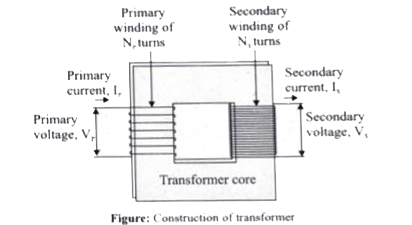Explain the construction and working of transformer.Solution in Tamil
Principle: The principle of transformer is the mutual induction between two coils। That is। when an electric current passing through a coil changes with time, an emf is induced in the neighbouring coil। Construction: In the simple construction of transformers, there are two coils of high mutual inductance wound over the same transformer core। The core is generally laminated and is made up of a good magnetic material like silicon steel। Coils are electrically insulated but magnetically linked via transformer core। The coil across which alternating voltage is applied is called primary coil P and the coil from which output power is drawn out is called secondary coil S। The assembled core and coils are kept in a container which is filled with suitable medium for better insulation and cooling purpose।
Construction: In the simple construction of transformers, there are two coils of high mutual inductance wound over the same transformer core। The core is generally laminated and is made up of a good magnetic material like silicon steel। Coils are electrically insulated but magnetically linked via transformer core। The coil across which alternating voltage is applied is called primary coil P and the coil from which output power is drawn out is called secondary coil S। The assembled core and coils are kept in a container which is filled with suitable medium for better insulation and cooling purpose।
Working: If the primary coil is connected to a source of alternating voltage, an alternating magnetic flux is set up in the laminated core। If there is no magnetic flux leakage, then whole of magnetic flux linked with primary coil is also linked with secondary coil। This means that rate at which magnetic flux changes through each turn is same for both primary and secondary coils।
As a result of flux change, emf is induced in both primary and secondary coils। The emf induced in the primary coil is almost equal and opposite to the applied voltage and is given by
The frequency of alternating magnetic flux in the core is same as the frequency of the applied voltage। Therefore, induced emf in secondary will also have same frequency as that of applied voltage। The emf induced in the secondary coil ε is given by
where , and are the number of turns in the primary and secondary coil, respectively। If the secondary circuit is open, then where is the voltage across secondary coil
From equations(1)and(2)।
This constant K is known as voltage transformation ratio। For an ideal transformer, Input power = Output power where i and i are the currents in the primary and secondary coil respectively। Therefore,
Equation(4)is written in terms of amplitude of corresponding quantities,
(i) If and . This is the case of step-up transformer in which voltage is increased and the corresponding current is decreased.
(ii) If. This is step-down transformer where voltage is decreased and the current is increased
Topper's Solved these Questions
Similar Questions
A conductor of linear mass dendity 0.2 g m−1 suspended by two flexible wire as shown in figure. Suppose the tension in the supporting wires is zero when it is kept inside the magnetic field of 1 T whose direction is into the page.
Compute the current inside the current and also the direction for the current . Assume g=10 ms−2

View SolutionExplain in detail the construction and working of a Van de Graaff generator.
View SolutionDerive an expression for the torque experienced by a dipole due to a uniform electric field.
View SolutionExplain the construction and working of transformer.
View SolutionWith a diagram, explain the working of a transformer.
View SolutionDescribe the construction and working of standard hydrogen electrode.
View SolutionExplain construction and working of photodiode.
View SolutionExplain the construction and working of clinical thermometer.
View SolutionExplain the construction and working of an Telephone.
View SolutionExplain the construction of transformer. Mention its principle.
View SolutionExplain the construction and working of photodiode
View SolutionExplain the construction and working of Aled.
View SolutionDescribe the construction and working of a transformer with a neat labelled diagram
View Solutionwith neat diagram describe the principal construction and working of a transformer.
View SolutionA transformer works with AC but not with DC, Explain.
View Solution

